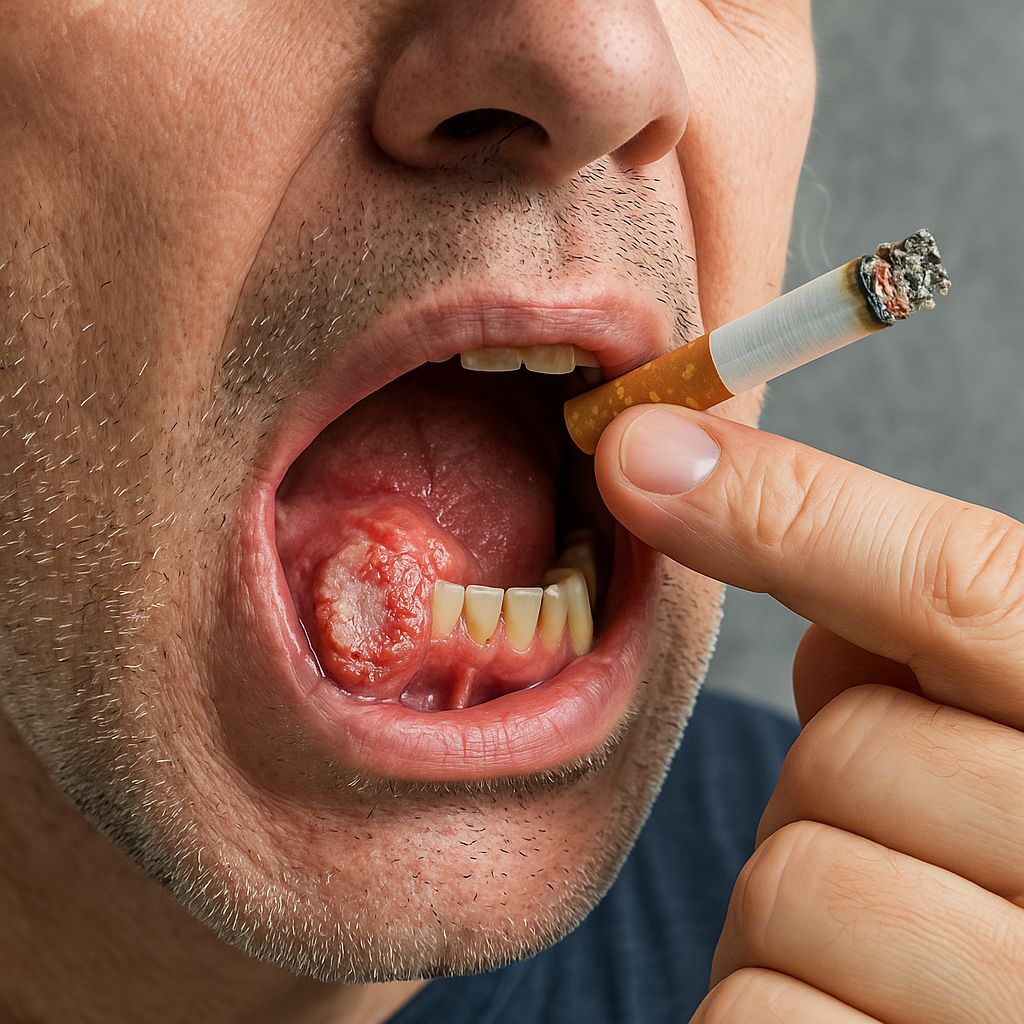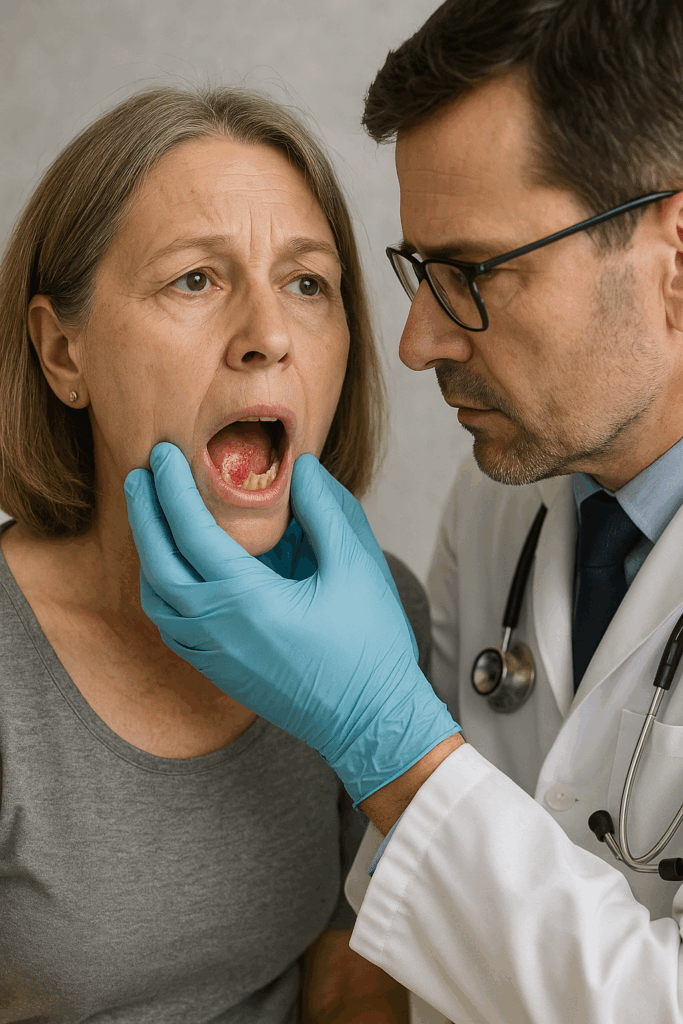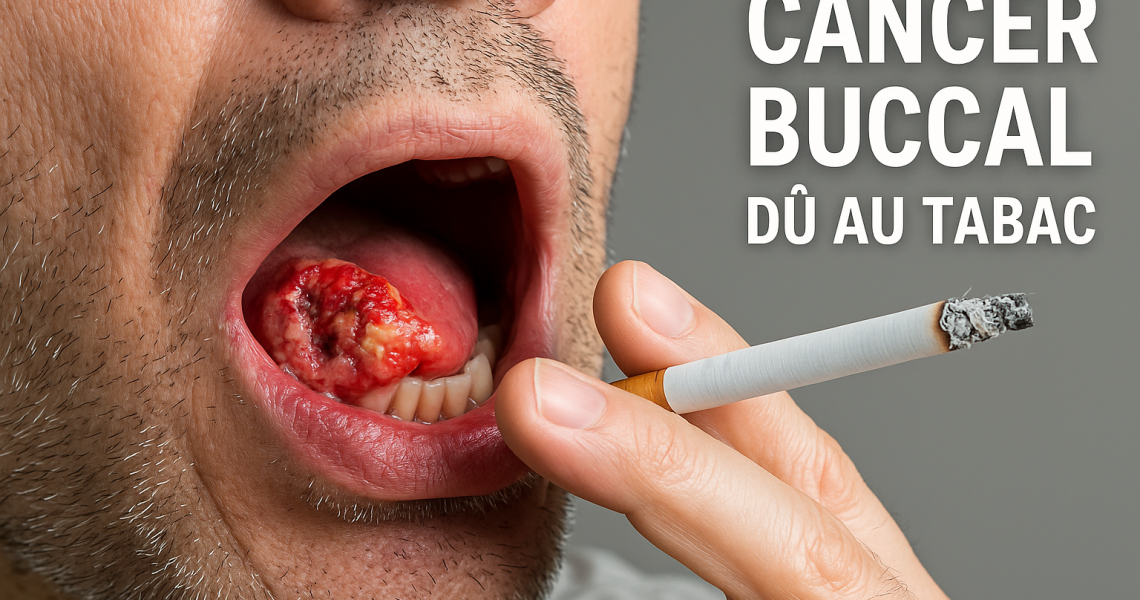Tobacco is one of the most important risk factors for the development of many cancers, and oral cancer is no exception. Every year in France, over 2,000 new cases of oral cancer are diagnosed. These diseases are often linked to prolonged tobacco consumption and factors such as alcohol. This article details the mechanisms linking smoking to oral cancer, the warning signs, and essential prevention strategies to protect yourself.

The link between smoking and oral cancer
To understand the impact of tobacco on oral health, it is necessary to analyze the toxic substances it contains and their cumulative effect on the tissues of the oral cavity.
1. Toxic chemicals in cigarettes
Each cigarette contains over 7,000 chemical compounds, 69 of which are known carcinogens. Among them, tar, nicotine and polycyclic aromatic hydrocarbons (PAHs) play a major role in damaging the cells of the mouth and pharynx.
These compounds weaken oral tissues and disrupt their ability to regenerate. They create an environment conducive to the development of genetic mutations, leading to precancerous or cancerous lesions. The deleterious effects of tobacco also affect the larynx, throat and lungs, increasing the risk of death from respiratory diseases.
2. The role of tobacco consumption in cancer formation
The correlation between smoking and oral cancer is well established. In France, 75% of oral cancers are linked to smoking. Long-term smokers are 5 to 10 times more likely to develop oral cancer than non-smokers.
Each inhalation exposes the tissues of the oral cavity and pharynx to high levels of toxicity. This damage also affects people exposed to passive smoking, increasing the risk of serious illness even in those who do not smoke directly.
3. The impact of other forms of smoking
While cigarettes are often singled out for blame, other smoking practices such as pipes, cigars and chewing tobacco are no less harmful. These forms directly expose the mouth and throat to highly carcinogenic substances. In France, the combination of tobacco and alcohol doubles the risk of developing oral cancer, as alcohol amplifies the effects of toxic substances.
Warning signs not to be ignored
Early identification of early signs can be decisive in the treatment of oral cancer. Here are the main indicators to look out for.
1. Visible lesions in the mouth
Early signs include:
- White (leukoplakia) or red (erythroplakia) spots on the gums, tongue or inside cheeks.
- Ulcerations that do not heal after two weeks.
- Increased sensitivity or unusual pain in the oral cavity or throat.
These symptoms may go unnoticed or ignored. Yet they require prompt medical attention to rule out any risk.
2. Functional modifications
As the disease progresses, changes appear. Patients may have difficulty swallowing, speaking or chewing. These symptoms often affect the throat and pharynx, indicating a possible extension of the lesions.
3. Swollen lymph nodes
Persistent swelling in the neck is a common symptom of advanced oral cancer. This sign may indicate the spread of cancer cells beyond the oral cavity.
Why is oral cancer often detected late?
Unfortunately, early diagnosis of oral cancer remains rare. The reasons for this need to be explored in order to raise awareness among at-risk populations.
1. Absence of initial pain
In its early stages, oral cancer is often painless. This characteristic leads many people to ignore the early signs, thus delaying diagnosis. Lesions, although established, do not usually cause immediate discomfort. This leads to late diagnosis, often when the disease is at an advanced stage.
The tissues of the mouth and pharynx, exposed to regular aggression from tobacco and alcohol, become insensitive to numerous irritations. This insensitivity masks the first symptoms and postpones medical consultation.
2. Lack of awareness
In France, many smokers underestimate the risks associated with smoking. Lack of information about the symptoms or diseases associated with passive smoking also contributes to this lack of awareness. The general population does not always associate oral abnormalities with warning signs of potential cancers.
An inadequate awareness campaign, coupled with the trivialization of the first symptoms, is holding back prevention efforts. Late returns from patients to healthcare professionals remain frequent.
3. Insufficient medical examinations
The lack of systematic screening for oral cancer also exacerbates the delay in diagnosis. Unlike other cancers such as breast or colon cancer, oral cancer screening is not yet common practice, which reduces the chances of detecting the disease at an early stage.
Prevention and risk reduction
To reduce the risk of developing oral cancer, a number of preventive measures can be taken.
1. Stop smoking
Quitting smoking is the most effective way to reduce the risks. By quitting smoking, the return to better oral health begins quickly:
- The tissues of the oral cavity regain their ability to regenerate.
- The risk of cancer decreases significantly after five years without smoking.
- Each page of information consulted on specialized platforms can offer practical advice to help you quit smoking.

2. Regular dental check-ups
Regular check-ups enable early detection of abnormalities. Dentists play a key role in France in the prevention and detection of precancerous lesions. They can also help you choose the right oral hygiene products.
3. Adopt strict oral hygiene
Effective daily brushing and flossing help limit the infections and inflammations that can worsen the effects of smoking. People who adopt these habits reduce the risk of tobacco-related oral complications.
4. Limit alcohol consumption
Reducing or eliminating alcohol from your daily intake helps mitigate its amplifying effects on tobacco’s toxic substances. Note that alcohol, combined with tobacco, multiplies the risk of cancer of the pharynx and throat.
5. Use nicotine replacement products
Nicotine substitutes, available in pharmacies, are an effective aid to withdrawal. They help reduce dependency while avoiding the side effects associated with abrupt cessation. Consult a healthcare professional to choose the right products for your situation.
You may also be interested in this article: Anti-smoking and addictions laser training
Available treatments
Treatment of oral cancer depends on the stage of the disease and may include:
1. Surgery
Surgery is often the first-line treatment for oral cancers. It involves removal of the tumor and, in some cases, adjacent affected tissues. When the cancer is at an advanced stage, partial or total removal of structures such as the tongue, gums or pharynx may be necessary.
Reconstructive techniques, such as skin grafts or bone reconstruction, restore aesthetic and functional functions. These complex procedures require specialized multidisciplinary teams.
2. Radiotherapy
Radiotherapy uses ionizing radiation to destroy cancer cells. This treatment is often used after surgery to eliminate residual cells, or as a first-line treatment for localized cancers. Although highly effective, it can cause side effects such as dry mouth, sore throat and altered taste.
Careful monitoring is needed to limit these inconveniences and adapt treatment to these effects.
3. Chemotherapy and immunotherapy
Chemotherapy is frequently used for advanced or metastatic oral cancer. It works by slowing the growth of cancer cells, and can be combined with surgery or radiotherapy to maximize the chances of success. However, this treatment can have side effects such as nausea, weight loss or severe fatigue.
Immunotherapy, on the other hand, is a more recent and promising method. It stimulates the patient’s immune system to target and destroy cancer cells. This treatment is particularly useful for cancers resistant to conventional therapies.
4. Palliative care
In cases where cancer is at a very advanced stage, palliative care is essential. It aims to improve the patient’s quality of life by reducing pain and providing emotional and medical support. Specialized teams also ensure that patients receive appropriate care to help them cope with the side effects of treatment.
Conclusion
Tobacco is a key factor in the development of oral cancers, as well as other serious diseases affecting the throat and lungs. Greater awareness of the risks, combined with preventive actions such as smoking cessation, regular dental check-ups and strict oral hygiene, is essential to reduce these dangers.
Remember, it’s never too late to take action. Consult a healthcare professional to assess your situation and benefit from personalized advice. Every step towards a smoke-free lifestyle is a step towards better health for you and the people around you. Take care of yourself, today
If you want to stop smoking now, visit one of our anti-smoking laser centers near you.
